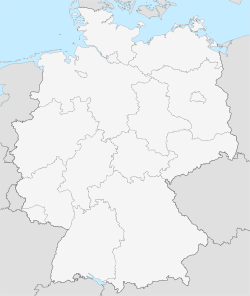Hildesheim
| Hildesheim | |
| Coat of arms | Location |
 |
 |
| Administration | |
| Country | Germany |
|---|---|
| State | Lower Saxony |
| District | Hildesheim |
| Mayor | Kurt Machens |
| Basic statistics | |
| Area | 92.96 km² (35.9 sq mi) |
| Elevation | 78 m (256 ft) |
| Population | 103,249 (30/12/2006) |
| - Density | 1,111 /km² (2,877 /sq mi) |
| Other information | |
| Time zone | CET/CEST (UTC+1/+2) |
| Licence plate | HI |
| Postal codes | 31101–31141 |
| Area code | 05121 |
| Website | www.hildesheim.de |
Hildesheim is a city in Lower Saxony, Germany. It is located in the district of Hildesheim, about 30 km southeast of Hanover on the banks of the Innerste river, which is a small tributary of the Leine river. It may be reached from Autobahn A7, which links Kassel, Göttingen and Hanover, and routes 1, 6, 243 and 494.
Contents |
History
The town became the seat of the Bishopric of Hildesheim in 815 and may have been founded when the bishop moved from Elze to the Innerste ford, where it was an important market on the Hellweg trade route. For four centuries the clergy ruled Hildesheim, before a town hall was built and the citizens gained some influence. In 1367 Hildesheim became a member of the Hanseatic League. A war between the citizens and their bishop was paid dearly when in 1519 to 1523 they engaged in a feud, and soon the town became protestant, and only the cathedral and a few more buildings remained in imperial (catholic) hands. In 1813, it became part of the Kingdom of Hanover after the Napoleonic Wars, which was annexed by the Kingdom of Prussia after the Austro-Prussian War in 1866 as a province.
The city was heavily damaged by air raids in 1945, especially on March 22. 28.5% of the houses were completely destroyed and 44.7% damaged. 26.8% of the houses remained undamaged. The centre, which had retained its medieval character until then, was levelled. After the war, it was rebuilt in a completely different style and concrete structures took the place of the destroyed buildings. Fortunately, most of the major churches, two of them now UNESCO World Heritage Site, had been rebuilt soon after the war. During the war, the valuable world heritage had been hidden in the basement of the city wall. In the 1978, the University of Hildesheim was founded. In the 1980s a reconstruction of the historic centre began. Some of the unattractive concrete buildings around the marketplace were torn down and replaced by replicas of the original buildings. In the fall of 2007, a decision has been made to reconstruct the "Umgestülpter Zuckerhut" ("Upended Sugarloaf"), an iconic half-timbered house famous for its unusual shape. It is scheduled to be completed in 2009.
Main sights





- The historic Marketplace (Markt) was once considered one of the most beautiful marketplaces in the world. It was reconstructed in 1984-1990 to its former splendour, after its destruction in the 1945 air raid. The more noteworthy buildings in the square are:
- The Knochenhauer-Amtshaus ("Butchers' Guild Hall"), known as a beautiful and fine specimen of half-timbered building. Originally built in 1529 and destroyed in 1945, it was reconstructed from 1987 to 1989 according to original plans. The facade is sumptuously decorated with colorful paintings and German proverbs. Today the building houses a restaurant and the City Museum.
- The Town Hall, erected in the 13th century in Gothic style. Partly destroyed in 1945, it was rebuilt between 1954 and 1989.
- The Tempelhaus, a late-Gothic 15th-century patrician house, which today houses the tourist information office. It suffered some damage during the second world war but was restored in 1952.
- The Wedekindhaus, a 16th-century patrician house, is characterized by its high, ornately carved storeys including their ledges with depictions of allegorical figures.
- The Romanesque St. Mary's Cathedral, with its ancient bronze doors (Bernward's door) (c. 1015). The church was built in the 9th century, but almost completely destroyed in 1945; it was reconstructed soon after the war. It is in the list of the UNESCO World Heritage Site since 1985. The Thousand-Year-Old Rosebush is a 1,000 years old rose, allegedly the world's oldest living rose. It continues to flourish on the wall of the Cathedral.
- Museum of the Cathedral: Cathedral Treasure.
- St. Michael's Church (UNESCO World Heritage Site) – a noteworthy early Romanesque church in Germany and a unique example of Ottonian architecture. It was built from 1010 to 1022.
- The Andreaskirche (St. Andrew's church), a 12th-century church with the highest church steeple (114 m) of Lower Saxony. From the top you get an interessting view of Hildesheim and its sourroundings.
- The Roemer-und-Pelizaeus-Museum, with significant collections from the ancient Egypt and Peru and spectacular special exhibitions organized every year.
- The Kreuzkirche (Church of the Holy Cross) was originally a part of the medieval fortifications. It was converted into a church around 1079, severely damaged in 1945 and rebuilt after the war.
- The Godehardikirche (St. Godehard's Church), built 1133-1172, a romanic Basilica minor which is supposed to become a UNESCO World Heritage Site in the near future.
- The Kehrwiederturm (Kehrwieder Tower), built around 1300, is the only remaining tower of the medieval fortifications.
- Half-timbered houses which were not destroyed during World War II can be seen around St. Godehard's Church and the Kehrwieder Tower, in the streets Kesslerstrasse, Knollenstrasse, Am Kehrwieder, Gelber Stern, Lappenberg, Bruehl, Hinterer Bruehl, Godehardsplatz. Some of them have beautiful wood carvings in their facades, e.g. the Wernersches Haus (1606) at Godehardsplatz and the Waffenschmiedehaus (1548) at Gelber Stern.
- The Monument of the Synagogue (consecrated in 1849 and destroyed in 1938) was erected in 1988 in the old Jewish quarter in the street Lappenberg, one of the most beautiful streets of Hildesheim. The foundations were reconstructed and give you an idea how big the synagogue was. The reddish brick building (built around 1840) opposite was the Jewish school.
- Mauritiuskirche (St. Mauritius Church), romanic church (11th century) on a hill in the West of the city in the district of Moritzberg with a beautiful cloister. The interior of the church is baroque and the tower was added in 1765. From the forest behind the church you get a beautiful view of Hildesheim with many different churches.
- Kaiserhaus (Emperor's House): Renaissance building (1586) in Alter Markt, the oldest street of Hildesheim, rebuilt after the war. The facade is decorated with Roman statues and medaillons.
- Saint Magdalena's Church (Magdalenenkirche) is a small romanic church in the West of the city center which was consecrated in 1224 and enlarged in 1456. It houses a wooden altar (about 1520) with carvings and other pieces of art. The baroque parc Magdalena's garden(Magdalenengarten) is close by. There are many different kinds of rose bushes, a rose museum, baroque statues, a well-preserved part of the medieval city wall and even a vineyard in it.
- Steuerwald Castle (Burg Steuerwald) in the North of the city, about 3 km from the Market Place, was built 1310-1313. Its tower (25 m) was added in 1325. The chapel, dedicated to Saint Magdalena, was originally built in 1310 in the romanic style and transformed into a gothic chapel in 1507. Today it is used for weddings and concerts.
- Marienburg Castle (Burg Marienburg) in the Southeast of Hildesheim is about 6 km from the Market Place. It was built 1146-1349.
- Marienrode Monastery (Kloster Marienrode) is in the Southwest of Hildesheim about 6 km from the Market Place. It was founded in 1125. The gothic church was consecrated in 1462. The monastery was dissolved in 1806, but returned to the Catholic Church in 1986. Since 1988, it has been operated by nuns again. Near the monastery there is a beautiful lake and a tall windmill. The area is specially beautiful during cherry blossom.
Other places of interest include the Theatre, offering opera, operetta and musicals, drama, ballet and concerts and the medieval-appearing half-timbered houses.
Districts
- 001 Mitte (central)
- 002 Neustadt
- 003 Nord (north) with Steuerwald
- 004 Süd (south)
- 005 Ost (east)
- 006 Galgenberg and Marienburger Höhe
- 007 Drispenstedt ¹
- 008 West (west)
- 009 Moritzberg
- 010 Neuhof with Hildesheimer Wald ²
- 011 Ochtersum ¹
- 012 Marienrode ²
- 013 Sorsum ¹
- 014 Himmelsthür ¹
- 015 Bavenstedt ¹
- 016 Einum ¹
- 017 Achtum-Uppen ¹
- 018 Itzum ¹
- 019 Marienburg
¹ one district
² districts with two districts
Incorporations
- 1911: Moritzberg
- 1912: Steuerwald
- 1938: Drispenstedt and Neuhof
- 1971: Ochtersum
- 1974: Achtum-Uppen, Bavenstedt, Einum, Himmelsthür, Itzum, Marienburg, Marienrode and Sorsum
Population history
| Year | Population |
|---|---|
| 1400 | ca. 6,000 |
| 1450 | ca. 8,000 |
| 1648 | ca. 5,500 |
| 1803 | 11,108 |
| 1825 | 12,630 |
| 1849 | 14,651 |
| 1871 | 20,801 |
| December 1, 1875 ¹ | 22,581 |
| December 1, 1890 ¹ | 33,481 |
| December 1, 1900 ¹ | 42,973 |
| December 1, 1910 ¹ | 50,239 |
| October 8, 1919 ¹ | 53,499 |
| June 16, 1925 ¹ | 58,522 |
| June 16, 1933 ¹ | 62,519 |
| May 17, 1939 ¹ | 72,101 |
| September 13, 1950 ¹ | 65,531 |
| June 6, 1961 ¹ | 96,296 |
| December 31, 1970 | 93,400 |
| June 30, 1975 | 106,000 |
| June 30, 1980 | 102,700 |
| June 30, 1985 | 100,900 |
| January 1, 1989 | 103,512 |
| June 30, 1997 | 105,700 |
| December 31, 2002 | 103,448 |
¹ census data
List of mayors of Hildesheim
- 1803-1843: Georg Otto Ferdinand Lohde
- 1843-1848: Carl Christoph Lüntzel
- 1848: Commissioned by Oberg, Starke and Wynecken
- 1848-1852: Amtsassessor Domeier
- 1853-1875: Paul Johann Friedrich Boysen
- 1876-1895: Gustav Struckmann
- 1895-1896: Hans Ukert, not as mayor
- 1896-1909: Gustav Struckmann, reelected
- 1909-1937: Ernst Ehrlicher
- 1945-1946: Erich Bruschke
- 1946-1950: Albin Hunger
- 1950-1952: Friedrich Lekve
- 1952-1958: Albin Hunger, reelected
- 1958-1959: Paul Lienke
- 1959-1964: Martin Boyken
- 1964-1968: Friedrich Nämsch
- 1968-1972: Martin Boyken, reelected
- 1972-1975: Friedrich Nämsch, reelected
- 1975-1981: Heiko Klinge
- 1981-1991: Gerold Klemke
- 1991-2001: Kurt Machens
- 2001-2005: Dr. Ulrich Kumme
- 2005-present: Kurt Machens, reelected
Twinnings

 Angoulême, France, since 1965
Angoulême, France, since 1965 Al Minya, Egypt, since 1975
Al Minya, Egypt, since 1975 Weston-super-Mare, United Kingdom, since 1983
Weston-super-Mare, United Kingdom, since 1983 Padang, Indonesia, co-op city since 1988
Padang, Indonesia, co-op city since 1988 Halle, Germany, friend partnership since 1990
Halle, Germany, friend partnership since 1990 Gelendzhik, Russia, since 1992
Gelendzhik, Russia, since 1992 North Somerset, United Kingdom (unitary authority based in Weston-super-Mare), since 1997
North Somerset, United Kingdom (unitary authority based in Weston-super-Mare), since 1997 Pavia, Italy, since 2000
Pavia, Italy, since 2000
Events of international interest
- M'era Luna Festival, Europe's most important event of the gothic and wave scene
- Jazz festival every May or June
Economy
Hildesheim is home to notable multinational corporations – besides many strong medium-sized companies – in Hildesheim are Blaupunkt, Bosch, Krupp, Thyssen, Fairchild and Coca-Cola.
Transportation
Hildesheim has an efficient traffic infrastructure: it is a regional hub for interstate roads and railroad (InterCityExpress), is connected to the motorway (Autobahn), has a harbor at the artificial waterway Mittellandkanal and an airport.
Notable residents
- Rudolf Schenker, founder and guitarist of Scorpions
- Saint Godehard, also known as St. Gotthard, bishop of Hildesheim
- St. Bernward, bishop of Hildesheim
- Didrik Pining, who traveled to The Americas in 1473 – 20 years before Christopher Columbus
- Frederick Hornemann, African explorer
- Henry Rathbone, U.S. Consul, historical personage imprisoned in Hildesheim.
- Sir Hans Adolf Krebs, Nobel Prize in Physiology and Medicine in 1953
- Adolf Hurwitz, notable 19th century German mathematician
- Jakob Guttmann (1845-1919), chief rabbi, philosopher, pedagoge
- Julius Guttmann (1880-1950), German and Palestinian rabbi, Jewish philosoph historian
- Thomas Quasthoff, bass-baritone singer
- The twins Wolfgang and Christoph Lauenstein. The were winner of the Academy Awards in 1989 for their movie Balance
- André Schneider, actor
- Diane Kruger, supermodel and actress, who played in Troy
- Maik Taylor, Northern Ireland and Birmingham City footballer
- Oskar Schindler (1907-1974) died in Hildesheim
Gallery
External links
- The city's own website.
- 360° Panoramas Hildesheim
- Article about Hildesheim
- Travel guide for Hildesheim
- Pictures
|
|||||||